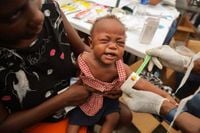In the heart of the Caribbean, Haiti is facing a hunger crisis that experts warn could soon become one of the world’s worst humanitarian emergencies. According to the Integrated Food Security Phase Classification (IPC), a United Nations-backed authority on global hunger, more than half of Haiti’s population—about 5.7 million people—are currently grappling with severe food shortages as of October 2025. Of this staggering figure, 1.9 million Haitians are already at emergency hunger levels, marked by dangerous malnutrition and severe food gaps. Another 3.8 million are classified as facing crisis-level food insecurity, setting the stage for a bleak outlook as the nation’s lean agricultural season approaches.
This crisis is not new, but it is deepening at an alarming rate. The IPC projects that by mid-2026, nearly six million Haitians could be suffering from acute hunger, with almost two million at emergency levels. While the country has managed to avoid the IPC’s most extreme phase—famine—so far, the situation remains precarious. Martine Villeneuve, Haiti director at the non-profit Action Against Hunger, told Reuters, “The current response is, by nature, short-term and cannot be sustained without stronger, long-term investment to tackle the root causes of food insecurity.” She added that although about 200,000 people are no longer at the emergency level, any progress is “fragile.”
What’s driving this catastrophe? The roots of Haiti’s food crisis are tangled in a web of economic, social, and political challenges. The country has endured six consecutive years of economic recession, according to Al Jazeera, with food prices skyrocketing by 33 percent in July 2025 compared to the previous year. This inflation has made it nearly impossible for millions to afford basic staples. Nearly six million Haitians now live on less than $2.41 a day, as reported by the Associated Press.
But the economic crisis is only part of the story. Gang violence has exploded, particularly in Port-au-Prince, the capital, where armed groups now control an estimated 90 percent of the city. Over the past year, these groups have expanded their reach into rural agricultural regions as well. This surge in violence has displaced 1.3 million people—a 24 percent increase since December 2024—forcing many to seek shelter in overcrowded, makeshift camps that lack even the most basic services.
The impact on agriculture has been devastating. Farmers who remain on their land are often forced to negotiate with gangs simply for access to their own fields, and in many cases, must surrender a portion of their harvests as payment. “Farmers who have managed to carry out their agricultural activities are forced not only to negotiate access to plots of land but also to share their produce,” the IPC report stated, as cited by the Associated Press. Even when harvests of corn, beans, rice, and tubers are close to normal, produce rarely makes it to the capital because gangs block the main roads, effectively cutting off food supplies to urban markets.
The violence has also crippled small businesses, a vital source of income for countless Haitian families. Many have closed their doors, unable to operate in areas controlled by armed groups. This has left large swathes of the population without any reliable means to support themselves, compounding the hunger crisis.
Children are bearing a particularly heavy burden. According to Al Jazeera, 680,000 children have been displaced by violence—nearly double previous figures. More than 1,000 schools have closed, and hundreds of minors have been recruited by armed groups, robbing an entire generation of both education and safety.
The crisis is further exacerbated by mass deportations from neighboring countries. The Associated Press reports that over 150,000 Haitians were deported from the United States and the Dominican Republic between January and September 2025. These returnees, often arriving with nothing, place even greater pressure on Haiti’s already strained resources. “These returnees…lacked everything and put increasing pressure on already scarce resources,” the IPC report noted.
In response to these dire circumstances, Haiti’s government announced on October 11, 2025, the creation of a Food and Nutrition Security Office to coordinate relief efforts. Louis Gérald Gilles, a member of the transitional presidential council, promised that authorities would “mobilize resources quickly to reach those most affected.” Yet, the government’s response faces enormous obstacles: the stranglehold of armed groups, logistical challenges, and chronic underfunding all threaten to undermine relief efforts before they can make a meaningful impact.
Despite the grim statistics, some observers see faint glimmers of hope. The absence of a full-blown famine, as classified by the IPC, is one such sign. However, Martine Villeneuve of Action Against Hunger cautioned that this should not lead to complacency. “Haiti remains among the five worst food-security crises globally, with more than half the population relying on assistance,” she said, emphasizing that the situation could deteriorate rapidly without sustained international support and long-term investment.
Structural problems and unfavorable climatic conditions continue to complicate Haiti’s path to recovery. The IPC report highlights how the growing influence of armed groups, combined with these persistent challenges, “continues to affect the food security of the Haitian population.” Makeshift shelters, impoverished communities in Port-au-Prince, and Haiti’s northwest and central regions are among the hardest hit.
For families displaced by violence, the daily struggle is relentless. Many live in cramped temporary sites, often without clean water, sanitation, or sufficient food. Small children—already vulnerable to disease and malnutrition—face even greater risks in such conditions. The closure of schools disrupts not only education but also access to school meal programs, which for many children are their only reliable source of nutrition.
The international community has taken note, but aid efforts are frequently stymied by security concerns and the logistical nightmare of reaching those most in need. Armed groups blocking roads and extorting aid convoys have made it nearly impossible for relief organizations to deliver food and medical supplies to some areas. Even when aid does get through, the sheer scale of the crisis means that resources are stretched thin.
As Haiti enters its lean agricultural season, the IPC warns that the number of people facing acute hunger could climb to nearly six million by mid-2026. With no clear end to the violence and economic turmoil in sight, the lives of millions hang in the balance. The world is watching, but for many Haitians, the wait for meaningful relief feels endless.
In a nation battered by years of hardship, the hunger crisis has become a daily reality for millions. Whether the government’s new initiatives and international aid can stem the tide remains uncertain. What is clear is that without sustained action and a focus on the root causes of hunger, Haiti’s crisis will only deepen—leaving a generation at risk and a country’s future in jeopardy.





